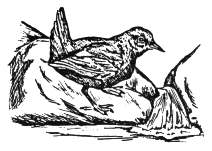Fascinating Facts About Birds
by Mina Arnold Young
|
Dipper
You might be walking by a mountain stream, in the far western part of the United States, and see a little gray or brown bird fly right up out of the water! Or you might see it flying into the water, or walking on the stream bed picking something off rocks or water plants.
Sometimes it stands on a rock that is sticking up out of the stream, bobbing up and down as if it had hinges where its legs are fastened on. That is why it got the name "dipper." Every time it dips it flicks its tail and blinks its white eyelids. Sometimes it stands on a rock and catches insects that float past.
 Many insects lay their eggs in water. When they hatch, the larva (little wormlike creatures,) live under water until they are ready to change to their adult form. Some of them fasten themselves to rocks or other underwater objects. These and other little water animals are food for the dipper.
Many insects lay their eggs in water. When they hatch, the larva (little wormlike creatures,) live under water until they are ready to change to their adult form. Some of them fasten themselves to rocks or other underwater objects. These and other little water animals are food for the dipper.
Like other birds, the dipper has just what it needs for the life it lives. Most water birds have an oil gland on the back, near the tail. They use this oil to spread over their feathers and make them waterproof. Dippers have unusually large oil glands. They oil their feathers so well that they never get wet. They never get cold either. They have a layer of down under their feathers that keeps them warm. You may even see them working in a frozen stream, going down through one hole in the ice and coming up through another. They have moveable flaps with which they can cover their nostrils. They can stay under water as long as 30 seconds at a time.
Jacana
|
Index
|
Home
 Many insects lay their eggs in water. When they hatch, the larva (little wormlike creatures,) live under water until they are ready to change to their adult form. Some of them fasten themselves to rocks or other underwater objects. These and other little water animals are food for the dipper.
Many insects lay their eggs in water. When they hatch, the larva (little wormlike creatures,) live under water until they are ready to change to their adult form. Some of them fasten themselves to rocks or other underwater objects. These and other little water animals are food for the dipper.